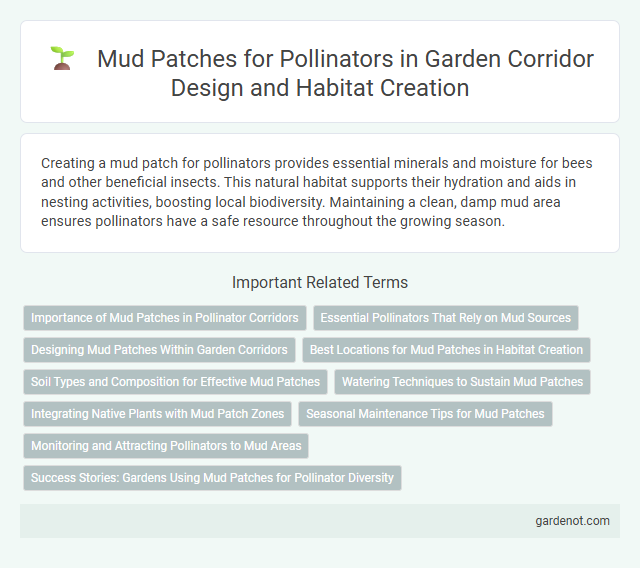Creating a mud patch for pollinators provides essential minerals and moisture for bees and other beneficial insects. This natural habitat supports their hydration and aids in nesting activities, boosting local biodiversity. Maintaining a clean, damp mud area ensures pollinators have a safe resource throughout the growing season.
Importance of Mud Patches in Pollinator Corridors
Mud patches in pollinator corridors provide essential water sources and minerals that support the hydration and nutrient needs of various pollinators like bees, butterflies, and other insects. These moist soil areas facilitate critical behaviors such as mud collection for nest-building and thermoregulation through water absorption. Maintaining mud patches enhances pollinator health and biodiversity, directly benefitting ecosystem pollination services and agricultural productivity.
Essential Pollinators That Rely on Mud Sources
Essential pollinators such as bees, especially species like the alkali bee and certain solitary bees, rely on mud patches to build their nests and complete their life cycles. These mud sources provide critical materials for constructing brood cells, enabling successful reproduction and population sustainability. Protecting and maintaining accessible mud patches within pollinator corridors enhances habitat quality and supports biodiversity crucial for ecosystem services like crop pollination.
Designing Mud Patches Within Garden Corridors
Designing mud patches within garden corridors enhances pollinator habitats by providing essential nesting sites for solitary bees and other beneficial insects. Incorporate areas with moist, well-drained soil that retains humidity without waterlogging, ensuring optimal conditions for egg-laying and larval development. Position mud patches near flowering plants to support foraging efficiency and increase pollination activity throughout the garden ecosystem.
Best Locations for Mud Patches in Habitat Creation
Ideal locations for mud patches in pollinator corridors include areas near water sources such as pond edges, stream banks, and low-lying wet soils that retain moisture. These spots provide essential materials for solitary bees, like mason and leafcutter bees, to build nests and lay eggs. Positioning mud patches adjacent to flowering plants enhances pollinator foraging efficiency and supports biodiversity within restored habitats.
Soil Types and Composition for Effective Mud Patches
Effective mud patches for pollinator corridors require well-balanced soil types with a mix of clay, silt, and sand to retain moisture while providing easy moldability for nest building. Loamy soils with moderate clay content create ideal conditions by ensuring adequate water retention and structural stability, supporting solitary bees and other ground-nesting pollinators. Consistent moisture levels and organic matter presence enhance the soil's texture, promoting optimal conditions for pollinator habitat development.
Watering Techniques to Sustain Mud Patches
Effective watering techniques for sustaining mud patches in pollinator corridors involve controlled, shallow irrigation that maintains consistent moisture without causing runoff or erosion. Utilizing drip irrigation or gentle spray methods ensures the soil remains damp, providing essential hydration for pollinator species like bees and butterflies to create nesting sites. Monitoring soil moisture levels regularly helps optimize water use, promoting healthy mud patches that support diverse pollinator habitats.
Integrating Native Plants with Mud Patch Zones
Integrating native plants with mud patch zones enhances pollinator corridors by providing essential foraging and nesting habitats for bees and other insects. Native plant species offer diverse pollen and nectar resources, while mud patches supply moisture and materials for nest construction. This combination supports biodiversity and improves pollinator health and reproduction within ecological networks.
Seasonal Maintenance Tips for Mud Patches
Seasonal maintenance of mud patches for pollinators involves regular moisture monitoring to ensure the substrate remains damp but not waterlogged, creating an ideal nesting environment for solitary bees. Clearing debris before spring stimulates fresh mud formation, essential for pollinators' nesting activities during peak seasons. Periodic soil aeration and replenishment of organic material enhance mud quality and support biodiversity within the pollinator corridor.
Monitoring and Attracting Pollinators to Mud Areas
Monitoring pollinator activity in mud patches involves regular observation and documentation of species visiting wet soil, which serves as essential mineral sources for bees and butterflies. Installing motion-activated cameras or conducting timed surveys during peak foraging hours enhances data accuracy on pollinator presence and behavior. Strategically placing shallow water basins with exposed mud and flowering plants nearby attracts diverse pollinators by providing hydration, nutrients, and shelter within the corridor.
Success Stories: Gardens Using Mud Patches for Pollinator Diversity
Gardens incorporating mud patches have successfully increased pollinator diversity by providing critical nesting habitats for solitary bees such as mason and sweat bees. These mud patches supply essential resources, enabling pollinators to construct nests and sustain their populations, which enhances pollination rates for surrounding plants. Studies show that such gardens experience heightened biodiversity and improved ecosystem health, demonstrating the effectiveness of mud patches in pollinator corridors.
Mud patch for pollinator Infographic

 gardenot.com
gardenot.com